More than twenty species of mammals have been recorded on Toronto’s Leslie Street Spit, an artificially constructed peninsula that juts into Lake Ontario from the city’s east end. With more than three million people, Toronto puts the kind of pressure on its parks and green spaces that should eliminate any hint of the wild and untamed. Yet somehow the Spit, also known as Tommy Thompson Park, has achieved the character of an “urban wilderness” that provides shelter and food for a population of mammals that range in size from the White-tailed Deer to the White-footed Mouse.
For more than sixty years, the Spit functioned as a landfill where Toronto dumped its construction rubble. The dumping ended years ago, and today the five-kilometer-long park has developed a variety of natural habitats that include meadows, prairies, ponds, marshes, and mixed deciduous and evergreen woods. In 2001, the Spit was designated an “Important Bird Area,” in part because of its nesting colonies of Ring-billed Gulls, Black-crowned Night Herons, Common Terns, and Double-crested Cormorants.
I live about a 15-minute bike ride north of the Spit. For twenty-five years or so, I’ve visited the park once or twice a week to observe and photograph the incredible diversity of its wildlife. What follows is my own very personal account of the mammals I’ve encountered in this unique and in some ways quite miraculous park. At the end of this essay, I have attached an annotated checklist of all the mammal species that have been recorded on the Spit.
It is rare that I actually catch sight of a White-tailed Deer (Odocoileus virginianus) on the Spit, but I see their tracks every time I’m there. From this I draw the obvious conclusion that like many wild animals, deer are experts at camouflage and evasion. And this is true despite their size. The deer are so large, that when I do see one, it always seems somehow out of place, as if it had wandered into the park by mistake and was looking for a means of escape.
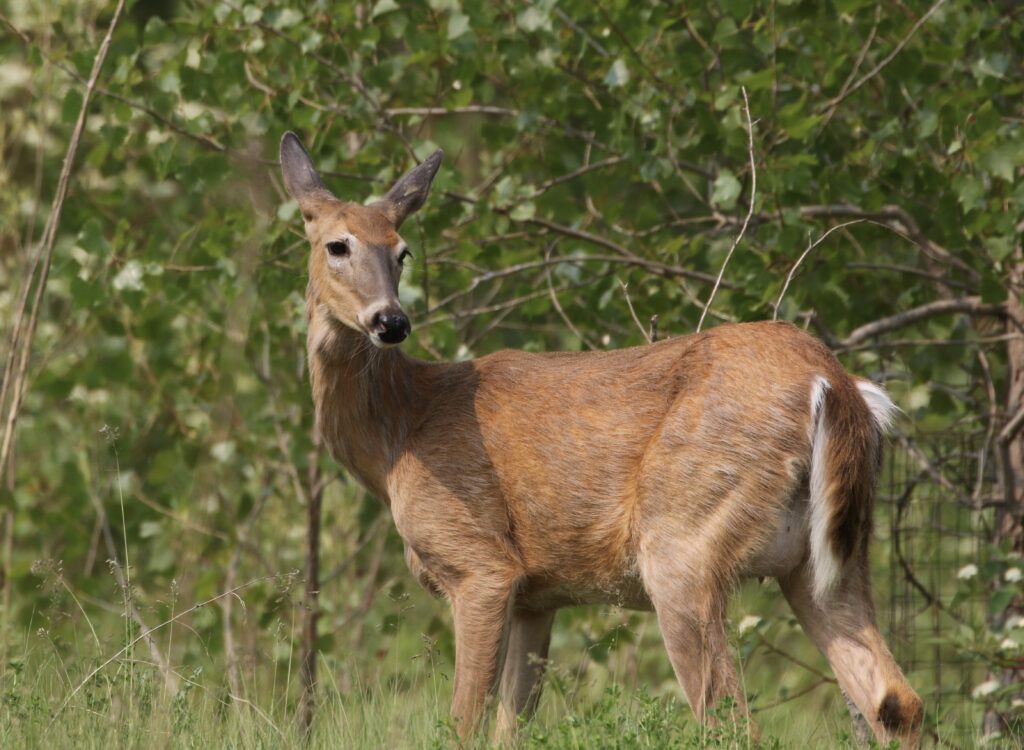
The deer try to avoid not just human beings, but also the predators—coyotes and foxes—that inhabit the park and that represent a threat especially to the young fawns. One spring morning, I stumbled upon a den that a pair of Coyotes (Canis latrans) had dug beneath a pile of concrete slabs. Six pups were outside, sleeping in the sun. They all rose to their feet when they saw me, but otherwise seemed unconcerned. After taking a few quick photos, I retreated. I never saw the parents but felt sure they were somewhere nearby, watching my every move.
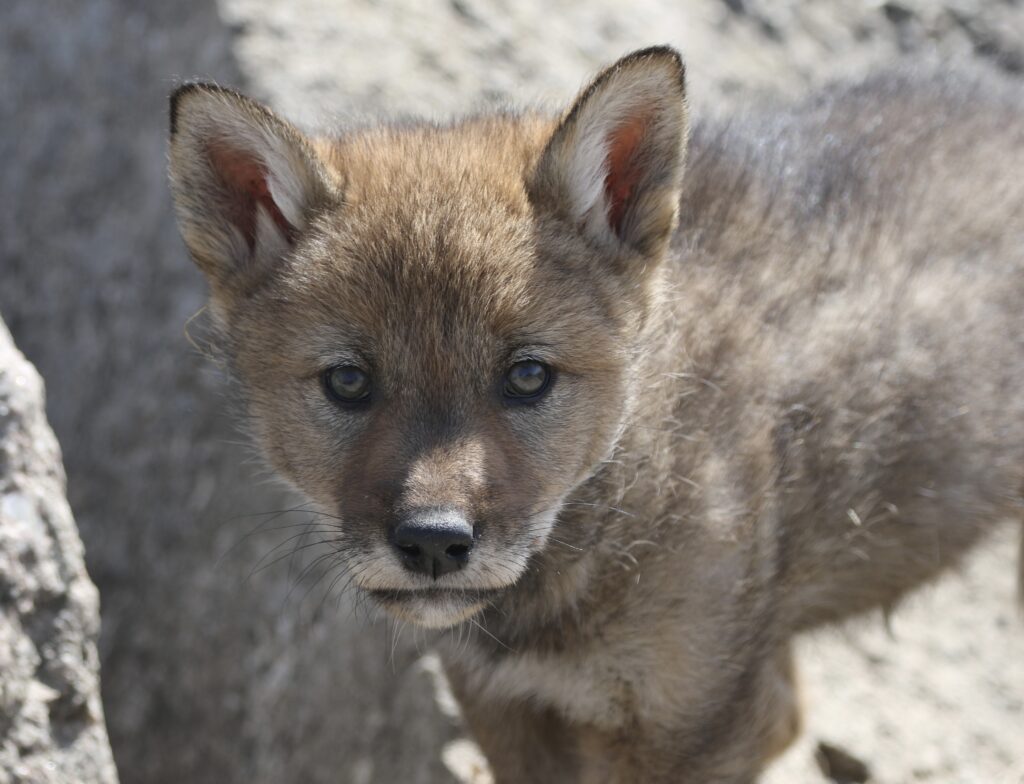
The Red Fox (Vulpes vulpes) seems to come and go on the Spit. A pair will establish a den for a year or two, raise a couple of litters, and then disappear, perhaps driven off by the coyotes. A few years ago, their den was near the lighthouse at the south end of the park. The kits would come out and wrestle on the pebbled beach while their parents supervised. Like well-tended children everywhere, the young foxes had set hours for exercise and play.
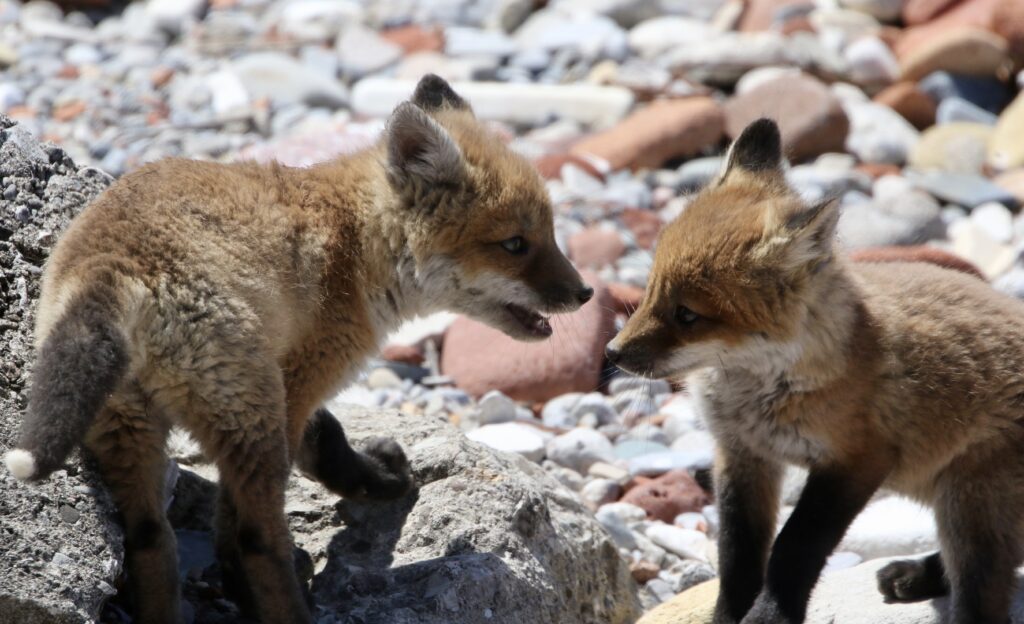
All of these predators are attracted to the Spit by the different species of rodents that infest every patch of vegetation in the park. Meadow Voles (Microtus pennsylvanicus) are a favored prey of both coyotes and foxes. Several times while watching the foxes, I saw one of the parents return from the hunt with its mouth crammed full of dead voles that it would deposit in a pile before the hungry kits.
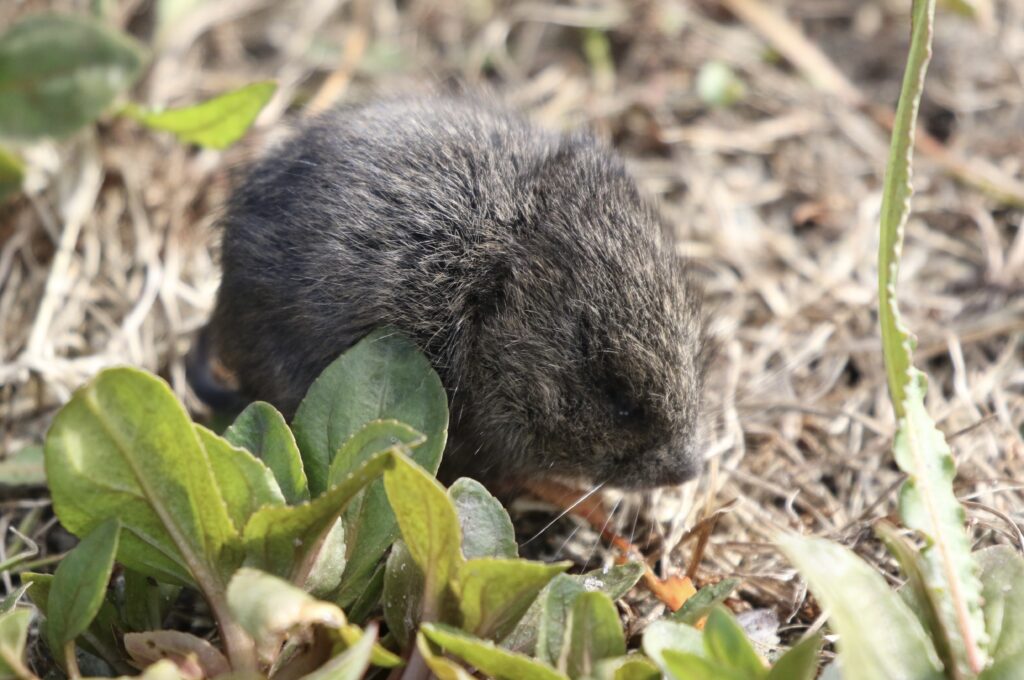
Once winter arrives, the predators seem to turn their attention to larger prey, especially to rabbits and squirrels. During my winter walks, I often see the bloody carcass of an Eastern Cottontail (Sylvilagus floridanus) torn to pieces and scattered on the snow, everything consumed except the hide and hair.
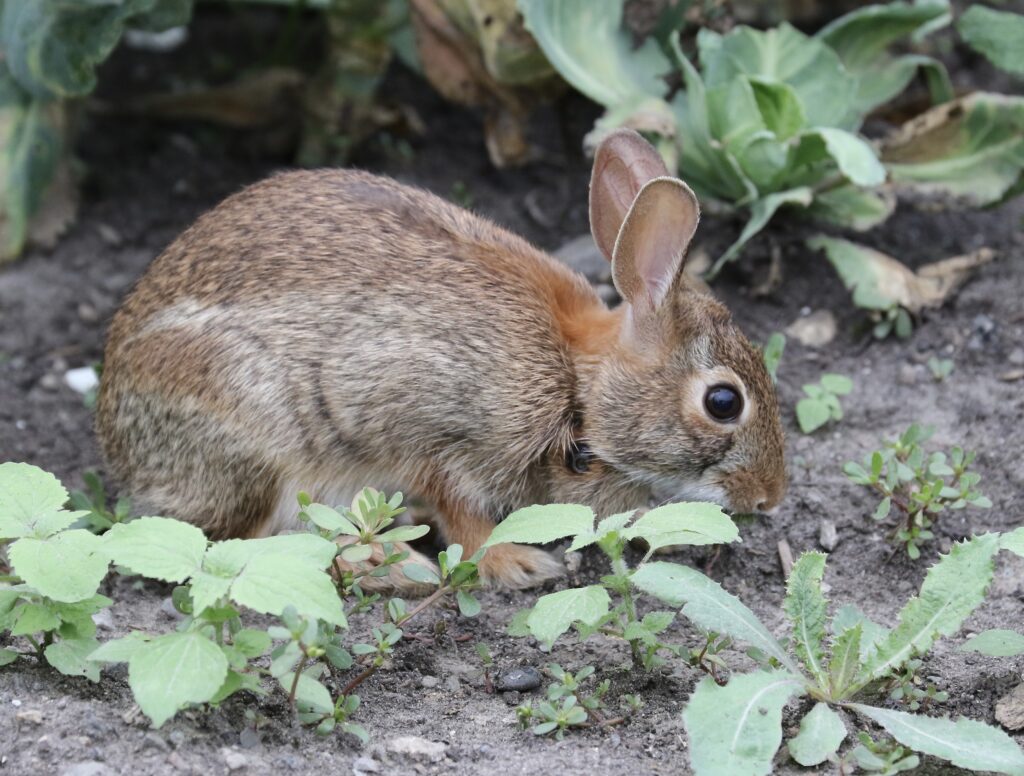
Foxes seem especially adept at preying on Eastern Grey Squirrels (Scirus carolensis), which also provide nourishment for the Great Horned and Barred Owls that spend the winter in the park.

The Spit is also home to certain species of mammals that naturalists refer to as “subsidized wildlife,” that is, those animals that thrive on the garbage that human beings produce in such vast quantities. The Common Raccoon (Procyon lotor) is easily seen on the Spit, and the Striped Skunk (Mephitis mephitis) is easy to smell. A third subsidized species, the Virginia Opossum (Didelphis virginiana) is a recent introduction. Partly because of its extreme shyness, the opossum is seldom seen.
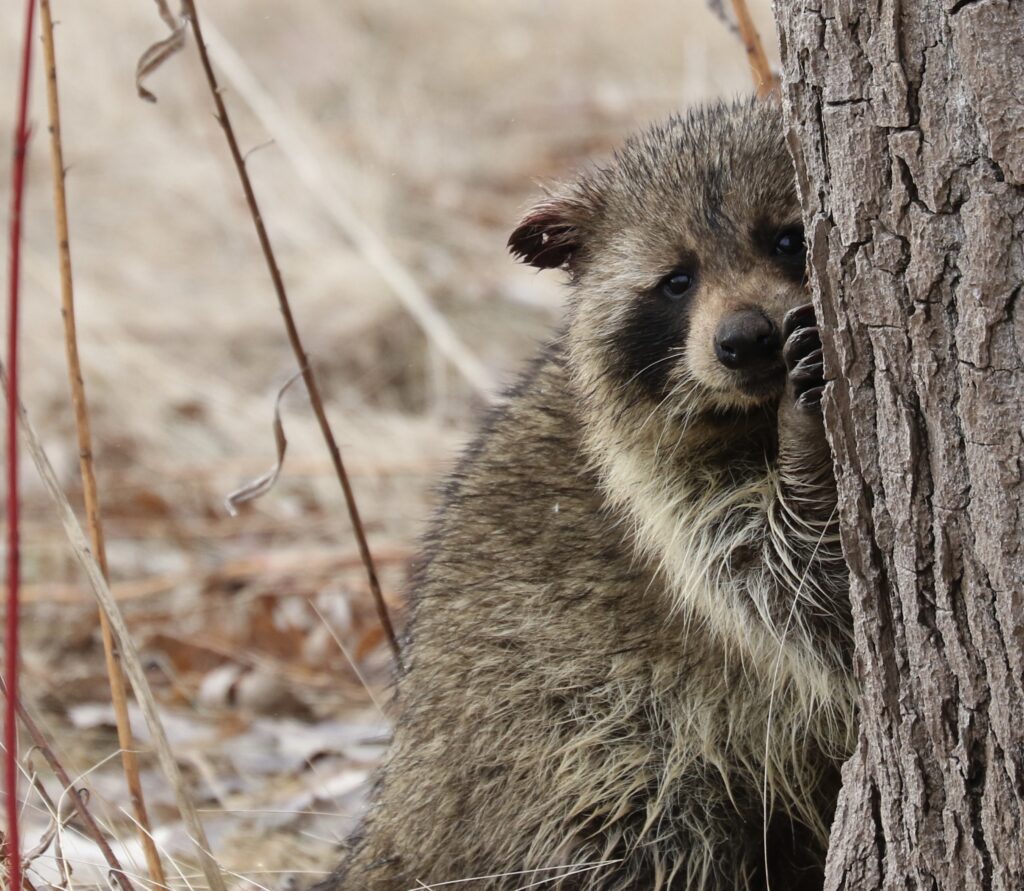
Perhaps the most fascinating class of mammals that inhabit the Spit is the aquatic one, which includes beavers, muskrats, and mink. As far back as I can remember, the Triangle Pond has hosted the lodge of an American Beaver, which also serves as a fishing platform for different species of herons and egrets.
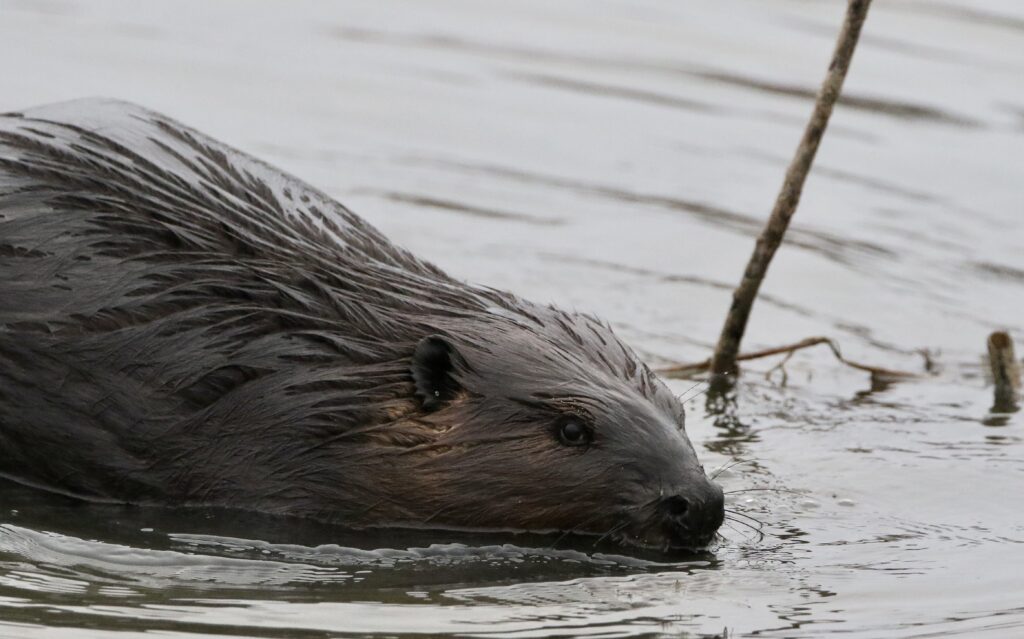

My personal favorite of all the mammals on the Spit is the American Mink (Neogale vison). This lithe and hyperactive weasel is ubiquitous in the park. I see at least one every time I’m there, and often several. By observing them for years, I’ve learned that mink are not only efficient hunters on land, but they are also incredibly skilled fishers. I’ve spent hours watching them slide into the water, then disappear beneath the surface for a minute or two and pop back up with a fish clamped between their jaws. Mink do not tolerate polluted environments. Their presence in such great numbers on the Spit indicates that the waters surrounding the park are relatively clean and teeming with fish. The mink also consume different types of crustaceans and bivalves, including crayfish and zebra mussels.

Now that I’ve dealt with land and water mammals, I’d like to conclude this brief survey by considering aerial mammals, in other words, the bats that inhabit the Spit. Four species of bats have been recorded in the park: Hoary, Big Brown, Silver-haired, and Eastern Red. Because I almost never go to the Spit in the evening, I hadn’t seen a bat there until quite recently. In October, I went down on a Saturday to look for caterpillars in a stand of oak trees at the southwest corner of the park. I enjoy searching through oak branches in the fall for some of the more spectacular caterpillars, such as that of the Polyphemus Moth (Antherea polyphemus).

I was working through the largest of the oaks, when I saw what looked like a small brown bag hanging from a leaf. At first, I thought it might be the egg case of a Praying Mantis, but when I looked closer, I was amazed to find an Eastern Red Bat (Lasiurus borealis). It was deeply asleep. When I held the branch down to get a better look, one eye opened briefly, but nothing else moved.

This is probably the most beautiful of the bats we see in Toronto. The fur on its back is a soft red color, almost the same shade as fine milk chocolate, while that on its belly is a vivid white. As with all bats, the ears are disproportionately large and finely formed. They are the perfect echo chambers for helping it to find the moths and other night-flying insects that form the bat’s regular diet.
Coming upon this strange, folded-up envelope of a creature so unexpectedly, I felt like Thoreau when he saw a Rose-breasted Grosbeak for the first time: that the act of discovery itself shocks us into an awareness of nature’s profundity. “How much it enhances the wildness and the richness of the forest,” he wrote in his Journal on 13 June 1853, “to see in it some beautiful bird which you never detected before.”
Maybe that’s the most important service that the mammals of the Spit perform for me. They enhance the wildness and the richness of this urban wilderness that has somehow developed and come to life on the edge of the fourth-largest city in North America.
| CHECKLIST OF THE MAMMALS OF THE LESLIE STREET SPIT | ||
| Common name | Scientific Name | Notes |
| Rodents | ||
| White-footed Mouse | Peromyscus leucopus | Common. A favorite prey of the Saw-whet Owls that winter on the Spit. |
| Deer Mouse | Peromyscus maniculatus | As above. |
| Meadow Vole | Microtus pennsylvanicus | Very common. Sustains local populations of foxes, coyotes, mink, and avian raptors. |
| Eastern Gray Squirrel | Sciurus carolinensis | Common. Both black and gray colour phases are present on the Spit. |
| Woodchuck | Marmota monax | Fairly common, especially in the Baselands. Individual specimens wander down to the Spit from the allotments on Leslie Street, where it is the bane of the gardeners. |
| Muskrat | Ondatra zibethicus | Common. Every pond has its lodge. |
| American Beaver | Castor canadensis | Common. A longstanding and emblematic mammal on the Spit. Mainly nocturnal, but evidence of its tree-felling activity is ubiquitous. |
| Rabbit Family | ||
| Eastern Cottontail Rabbit | Sylvilagus floridanus | Common throughout. |
| Weasel Family | ||
| Short-tailed Weasel (Ermine) | Mustela richardsonii | Very rare. I know of only one credible report of this species on the Spit from the early 2000s. Seen in its winter pelage crossing the ice-covered Triangle Pond. |
| American Mink | Neogale vison | Very common. Almost always seen either in or close by a body of water. |
| River Otter | Lutra canadensis | Extirpated from Toronto in the 20th century, this species has recently made something of a comeback. It has been reported on the Spit since 2019, first singly and now in family groupings. |
| Striped Skunk | Mephitis mephitis | Fairly common. Preyed on by the Great Horned Owls that winter on the Spit. |
| Opossum | ||
| Virginia Opossum | Didelphis virginiana | Uncommon and rarely seen. |
| Raccoon | ||
| Common Raccoon | Procyon lotor | Common. Most often seen asleep in the crook of a tree. |
| Dog Family | ||
| Red Fox | Vulpes vulpes | Comes and goes. When present, easily observed since it is active during the day and not terribly shy. |
| Coyote | Canis latrans | Common. Note that the Eastern Coyote averages about 10 pounds heavier than its western cousin. The question of the so-called Coy-wolf is too complicated to deal with here. |
| Hooved Animals | ||
| White-tailed Deer | Odocoileus virginianus | Uncommon, but its numbers seem to have increased in recent years. |
| Bats | ||
| Big Brown Bat | Eptesicus fuscus | Fairly common. This is the species most likely to make use of the bat boxes in the Baselands. Hibernates for the winter in caves and buildings. |
| Hoary bat | Lasiurus cinereus | Uncommon and seldom seen. |
| Silver-haired Bat | Lasionycteris noctivagans | Uncommon. During the day, most often seen sleeping on a tree trunk. |
| Eastern Red Bat | Lasiurus borealis | Uncommon. Most often encountered in fall migration. The Spit and Toronto Islands seem to be staging points for this species as it moves south. |

Nice job Ed. Very interesting and inspiring
Ed, I think this is my favourite of all your blogs. So interesting, and great photos to illustrate it. Thanks for sharing it. Merry Christmas to you and yours, and wishing you all the best for 2024.
Beautifully written. Wonderful pictures. Thank you for this overview of thriving nature on the edge of our city and lake waters. Much appreciated.
Many thanks for your comments–I’m very glad you enjoyed this post.